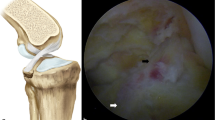Abstract
Background
Surgical treatment of bony avulsions of the posterior cruciate ligament (PCL) through a classic posterior approach carries a high risk of neurovascular compromise, and arthroscopic techniques are demanding. The purpose of this study is to report results of safe, minimal invasive surgical approach using pull-out suture fixation technique.
Materials and methods
This is a prospective study of 16 cases with avulsion of the posterior tibial spine, managed through minimally invasive posterior approach and fixed by pull out suture. All patients were males, of mean age 34.5 ± 5.5 years. Average follow-up period was 18 ± 4 months.
Results
The average operative time was 32 ± 3.75 min. X-rays showed satisfactory reduction and good bone healing in all cases at 3 months. Functional results were excellent in 13 patients, and near normal International Knee Documentation Committee (IKDC) score in the remaining 3 patients. Average Lysholm score was 95.2 ± 2.3, with no complications related to approach or fixation technique.
Conclusions
The presented minimally invasive posterior knee approach is easy and safe with adequate exposure of PCL avulsion fracture. Fixation technique by pull-out sutures is a reliable method of fixation of this kind of fractures that avoids the complications of metal hardware and subsequent need for removal.


Similar content being viewed by others
References
Hughston J (1969) The posterior cruciate ligament in knee joint stability. J Bone Joint Surg 51:1045–1046
Shelbourne K, Davis T, Patel D (1999) The natural history of acute, isolated, nonoperatively treated posterior cruciate ligament injuries: a prospective study. Am J Sports Med 27:276–283
Skyhar M, Warren R, Ortiz G (1993) The effects of sectioning of the posterior cruciate ligament and the posterolateral complex on the articular contact pressures within the knee. J Bone Joint Surg 75:694–699
Petrigliano F, McAllister D (2006) Isolated posterior cruciate ligament injuries of the knee. Sports Med Arthroscopy Rev 14:206–212
Griffith J, Antonio G, Tong C, Ming C (2004) Cruciate ligament avulsion fractures. Arthroscopy 20:803–812
Meyers M (1975) Isolated avulsion of the tibial attachment of the posterior cruciate ligament of the knee. J Bone Joint Surg 57:669–672
Torisu T (1979) Avulsion fractures to the tibial attachment of the posterior cruciate ligament: indications and results of delayed repair. Clin Orthop Relat Res 143:107–114
Burks R, Schaffer J (1990) A simplified approach to the tibial attachment of the posterior cruciate ligament. Clin Orthop Relat Res 254:216–219
Horas U, Meissner S, Heiss C, Schnettler R (2004) Arthroscopic fixation of posterior cruciate ligament avulsion fractures: a new minimally invasive technique. Knee Surg Sports Traumatol Arthrosc 18(6):781–783
Trickey E (1980) Injuries of the posterior cruciate ligament: diagnosis and treatment of early injuries and reconstruction of late instability. Clin Orthop Relat Res 147:76–81
Nicandri G, Klineberg E, CJ CW, Mills W (2008) Treatment of posterior cruciate ligament tibial avulsion fractures through a modified open posterior approach: operative technique and 12- to 48-month outcomes. J Orthop Trauma 22:317–324
Bali K, Prabhakar S, Saini U, Dhillon M (2012) Open reduction and internal fixation of isolated PCL fossa avulsion fractures. Knee Surg Sports Traumatol Arthrosc 20(2):315–321
Nikiforidis P, Babis G, Kateros K, Vlamis J, Korres D (2000) Isolated avulsion fracture of the tibial attachment of the posterior cruciate ligament. Eur J Orthop Surg Traumatol 10:257–259
Abbott L, Carpenter W (1945) Surgical approaches to the knee joint. J Bone Joint Surg 27:277–310
Ogata K (1980) Posterior cruciate reconstruction using iliotibial band. Preliminary report of a new procedure. Arch Orthop Trauma Surg 51:547–551
Deehan D, Pinczewski L (2001) Arthroscopic reattachment of an avulsion fracture of the tibial insertion of the posterior cruciate ligament. Arthroscopy 17(4):422–425
Chen S, Cheng C, Chang S, Tsai M, Chiu C, Chen AC, Chan Y (2011) Arthroscopic suture fixation for avulsion fractures in the tibial attachment of the posterior cruciate ligament. Arthroscopy 28(10):1454–1463
Gui J, Wang L, Jiang Y, Wang Q, Yu Z, Gu Q (2009) Single-tunnel suture fixation of posterior cruciate ligament avulsion fracture. Arthroscopy 25(1):78–85
Sasaki S, RdMe A, Amatuzzi M, Pereira C (2007) Open screw fixation versus arthroscopic suture fixation of tibial posterior cruciate ligament avulsion injuries: a mechanical comparison. Arthroscopy 23(11):1226–1230
Zhang X, Cai G, XU J, Wang K (2012) A minimally invasive postero-medial approach with suture anchors for isolated tibial avulsion fracture of the posterior cruciate ligament. Knee 20:96–99
Jazayeri S, Jah A, Karami M (2009) A safe postero-medial approach to posterior cruciate ligament avulsion fracture. Knee Surg Sports Traumatol Arthroscopy 17:244–247
Kim S, Shin S, Choi N, SK SC (2001) Arthroscopically assisted treatment of avulsion fractures of the posterior cruciate ligament from the tibia. J Bone Joint Surg 83(5):698–708
Shino K, Nakata K, Mae T (2003) Arthroscopic fixation of tibial bony avulsion of the posterior cruciate ligament. Arthroscopy 19(2):1–5
Shino K, Nakata K, Mae T (2003) Avulsion of the posterior cruciate ligament. Arthroscopy 19(2):1–5
Eggers A, Becker C, Weimann A (2007) Biomechanical evaluation of different fixation methods for tibial eminence fractures. Am J Sports Med 35:404–410
Author information
Authors and Affiliations
Corresponding author
Ethics declarations
Conflict of interest
Both authors have no conflict of interest to disclose and did not receive any fund or research grants.
Ethical approval
The study was approved by ethical committee of Banha University and was in accordance with the ethical standards of the institutional and national research committee and with the 1964 Helsinki Declaration and its later amendments or comparable ethical standards.
Informed consent
All patients signed an informed consent after clear explanation of the surgical procedure.
Funding
None
Rights and permissions
About this article
Cite this article
Singer, M.S., Halawa, A.M. Minimally invasive open reduction and fixation of avulsed tibial insertion of posterior cruciate ligament. Eur Orthop Traumatol 6, 357–361 (2015). https://doi.org/10.1007/s12570-015-0332-0
Received:
Accepted:
Published:
Issue Date:
DOI: https://doi.org/10.1007/s12570-015-0332-0




